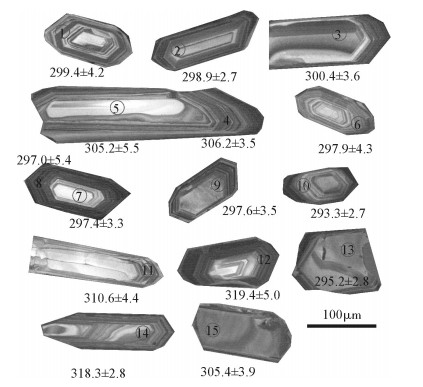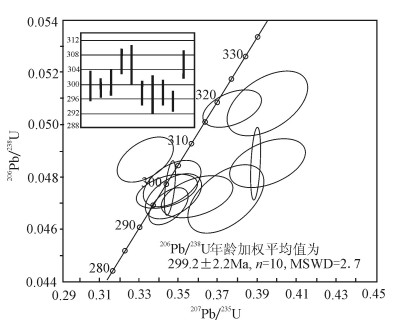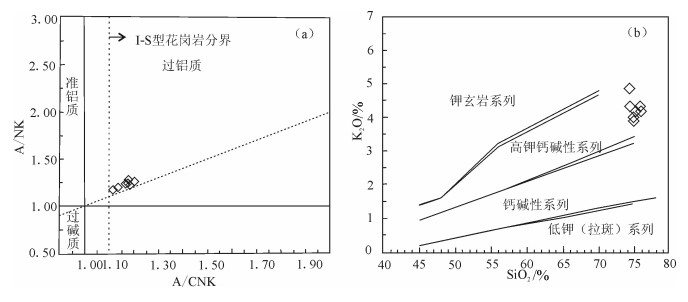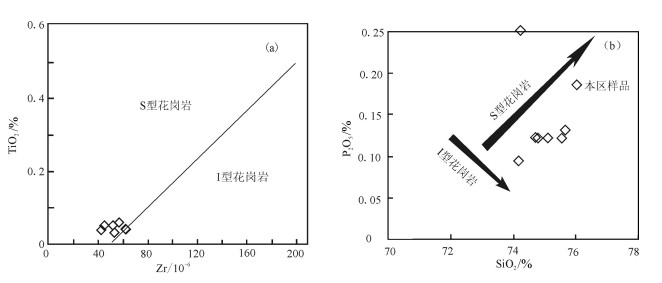Geochronology and geochem-ical characteristics of the Chaganhadayinhengga strongly peraluminous granites in East Ujimqin Banner of Inner Mongolia and their geological significance
-
摘要:
内蒙古东乌珠穆沁旗查干哈达音亨嘎强过铝质岩体位于华北板块与西伯利亚板块之间的中亚-蒙古造山带中东段的兴蒙褶皱带,主要岩石类型为含石榴子石二云母二长花岗岩。基于锆石U-Pb同位素定年、地球化学分析和构造环境判别,结合区域对比,认为查干哈达音亨嘎岩体源区可能与变质泥岩部分熔融有关,晚古生代,强过铝质花岗岩形成之前,二连—东乌旗一带已经发生了碰撞造山作用,之后为后碰撞-造山后的伸展扩张时期。经研究确定,查干哈达音亨嘎岩体为鲜有报道的石炭纪—早二叠世具有典型后碰撞特征的高温型强过铝质S型花岗岩类。
Abstract:The Chaganhadayinhengga strongly peraluminous granites in East Ujimqin Banner of Inner Mongolia are located in the Xing-Meng fold belt along the central and eastern section of Central Asia-Mongolia orogenic belt between the North China plate and the Siberia plate. The main rock type is garnet-bearing two-mica monzonitic granite. Based on zircon U-Pb isotopic dating, geochemical analysis and tectonic environment discrimination in combination with regional correlation, the authors have reached the following conclusions:The source area of the Chaganhadayinhengga rock mass might have been related to the partial melting of meta-morphosed mudstone; during Late Paleozoic period, before the formation of strong peraluminous granite, even Erlian-East Ujimqin Banner area underwent collisional orogeny, and then after collision, the evolution entered into the post orogenic extension-expan-sionl period. Studies show that the Chaganhadayinhengga rock mass belongs to the Carboniferous-Early Permian typical post colli-sional high temperature type peraluminous granites rarely reported by previous researchers.
-
Key words:
- S type granitoids /
- high temperature type /
- zircon U-Pb age /
- post collisional /
- East Ujimqin Banner
-

-
图 1 内蒙古东乌珠穆沁旗地区大地构造位置和地质简图(角图据参考文献[33])
Figure 1.
图 8 S型花岗岩Rb/Sr-Rb/Ba图解[14]
Figure 8.
表 1 含石榴子石二云母二长花岗岩单颗粒锆石U-Th-Pb激光烧蚀法测年数据(D4029-TW1)
Table 1. LA-ICP-MS zircon U-Th-Pb data of garnet-bearing two-mica monzonitic granites
测点编号 含量/10-6 Th/U 同位素比值 同位素年龄/Ma 206Pb 232Th 238U 207Pb/206Pb 1σ 206Pb/238U 1σ 207Pb/235U 1σ 208Pb/232Th 1σ 207Pb/206Pb 1σ 206Pb/238U 1σ 207Pb/235U 1σ 208Pb/232Th 1σ 谐和度 D4029- TW1-01 161 464 842 0.55 0.0524 0.0015 0.0475 0.0007 0.346 0.012 0.0152 0.0003 305.6 53.7 299.4 4.2 301.5 9.1 304.9 6.3 99% D4029- TW1-02 99 336 515 0.65 0.0528 0.0014 0.0475 0.0004 0.344 0.010 0.0152 0.0002 305.6 61.1 298.9 2.7 300.1 7.4 304.9 4.3 99% D4029- TW1-03 251 434 1323 0.33 0.0523 0.0011 0.0477 0.0006 0.347 0.010 0.0146 0.0003 283.4 37.0 300.4 3.6 302.5 7.4 292.0 5.1 99% D4029- TW1-04 395 562 1993 0.28 0.0494 0.0011 0.0486 0.0006 0.333 0.009 0.0147 0.0003 189.0 33.3 306.2 3.5 292.1 7.1 295.2 6.5 95% D4029- TW1-05 48 157 250 0.63 0.0588 0.0032 0.0485 0.0009 0.390 0.022 0.0149 0.0006 479.7 75.0 305.2 5.5 334.0 16.0 299.9 11.1 90% D4029- TW1-06 162 414 847 0.49 0.0651 0.0016 0.0473 0.0007 0.429 0.015 0.0171 0.0003 772.2 55.6 297.9 4.3 362.5 10.3 343.5 6.8 80% D4029- TW1-07 144 619 740 0.84 0.0549 0.0016 0.0472 0.0005 0.360 0.012 0.0151 0.0003 409.3 44.4 297.4 0 3.3 312.1 8.8 303.6 5.8 95% D4029- TW1-08 462 416 2460 0.17 0.0572 0.0014 0.0471 0.0009 0.374 0.013 0.0214 0.0004 498.2 25.9 297.0 5.4 322.9 9.3 427.9 8.5 91% D4029- TW1-09 210 406 1079 0.38 0.0531 0.0012 0.0472 0.0006 0.347 0.009 0.0156 0.0004 344.5 40.7 297.6 3.5 302.7 7.0 312.4 7.1 98% D4029- TW1-10 182 502 969 0.52 0.0632 0.0020 0.0465 0.0004 0.398 0.012 0.0168 0.0002 716.7 166.7 293.3 2.7 340.1 8.4 336.3 4.9 85% D4029- TW1-11 229 445 1128 0.39 0.0818 0.0022 0.0494 0.0007 0.545 0.014 0.0281 0.0010 1328. 7 58.3 310.6 4.4 441.8 9.2 560.4 19.3 65% D4029- TW1-12 166 334 763 0.44 0.0564 0.0017 0.0508 0.0008 0.395 0.013 0.0159 0.0003 450.1 52.8 319.4 5.0 338.1 9.7 318.8 6.4 94% D4029- TW1-13 403 448 1966 0.23 0.0533 0.0007 0.0469 0.0005 0.346 0.006 0.0158 0.0002 346.4 26.9 295.2 2.8 301.6 4.9 317.0 4.5 97% D4029- TW1-14 164 378 733 0.52 0.0539 0.0013 0.0506 0.0005 0.378 0.010 0.0161 0.0002 361.2 56.5 318.3 2.8 325.4 7.5 323.4 4.9 97% D4029- TW1-15 253 537 1168 0.46 0.0584 0.0015 0.0485 0.0006 0.395 0.013 0.0156 0.0003 538.9 51.9 305.4 3.9 338.3 9.3 313.4 5.2 90% 表 2 主量、微量和稀土元素含量及特征参数
Table 2. Major, trace element and REE composition for garnet-bearing two-mica monzonitic granites
含量 D4029-H1 D4142-H1 D4140-H1 D4139-H1 D4137-H1 D4136-H1 D4135-H1 SiO2 75.57 74.73 74.24 74.8 74.18 75.11 75.69 TiO2 0.051 0.033 0.042 0.044 0.053 0.061 0.039 Al2O3 13.59 14 13.78 13.8 13.69 13.52 13.65 Fe2O3 1.29 1.59 1.7 1.42 1.73 1.72 1.1 FeO 0.9 1.15 1.2 0.8 0.8 0.85 1 MnO 0.11 0.12 0.081 0.078 0.022 0.126 0.073 MgO 0.09 0.061 0.083 0.099 0.11 0.103 0.067 CaO 0.42 0.37 0.36 0.46 0.42 0.51 0.37 Na2O 4.11 4.18 3.9 4.08 3.68 3.66 3.76 K2O 4.34 4.06 4.35 3.94 4.88 4.21 4.21 P2O5 0.12 0.12 0.25 0.12 0.092 0.12 0.129 烧失量 0.22 0.5 1.01 0.93 0.94 0.69 0.9 总量 100.8 100.9 100.9 100.5 100.5 100.6 100.9 K2O+Na2O 8.45 8.24 8.25 8.02 8.56 7.87 7.97 K2O/Na2O 1.06 0.97 1.12 0.97 1.33 1.15 1.12 A/CNK 1.112 1.172 1.17 1.168 1.131 1.175 1.196 刚玉(C) 1.65 2.33 2.6 2.28 1.82 2.3 2.54 SI 0.84 0.55 0.74 0.96 0.99 0.98 0.66 AR 4.04 3.69 3.8 3.57 4.08 3.56 3.63 σ43 2.2 2.14 2.18 2.02 2.35 1.93 1.94 DI 93.62 92.52 92.65 92.72 93 91.93 93.18 Sc 4.58 5.72 4.18 4.43 3.05 3.58 3.96 Cr 17 15.5 20.1 23.9 23.6 16.2 12.6 Co 0.796 1.04 1.89 1.34 1.52 1.59 0.841 Ni 2.19 3.7 4.76 3.78 3.99 4.97 2.77 Rb 312 348 290 255 208 229 304 Nb 13 14.9 10.4 12.6 6.34 6.5 8.19 Ta 2.68 1.56 1.56 1.79 0.561 1.26 1.9 Th 6.63 8.42 7.73 7.78 6.29 5.58 6.07 Ba 35.6 19.6 60.4 62.9 63.3 87.1 35.4 Sr 19.1 10.9 25.9 35.1 36.5 36.5 14.8 V 2.75 3.9 5.52 7.05 8.36 17.6 7.23 Zr 44.5 53.1 62.1 61.9 51.6 56.8 43.4 Hf 2.52 3.58 3.16 3.1 2.5 2.66 2.63 K 36012.77 33689.36 36095.74 32693.62 40493.62 34934.04 34934.04 P 523.94 523.94 1091.55 523.94 401.69 523.94 563.24 Ti 306 198 252 264 318 366 234 Rb/Sr 16.335 31.927 11.197 7.265 5.699 6.274 20.541 Rb/Ba 8.764 17.755 4.801 4.054 3.286 2.629 8.588 Sr/Ba 0.537 0.556 0.429 0.558 0.577 0.419 0.418 Zr/Hf 17.659 14.832 19.652 19.968 20.64 21.353 16.502 Zr/Th 6.712 6.306 8.034 7.956 8.203 10.179 7.15 La 4.52 3.45 6.19 5.94 6.15 6.88 3.83 Ce 10.8 9.01 14.9 12.5 13.4 15.4 9.28 Pr 1.38 1.24 1.86 1.66 1.66 1.96 1.19 Nd 5.65 5.22 7.41 7.1 6.27 6.56 4.61 Sm 2.05 2.25 2.71 2.77 1.81 1.92 1.51 Eu 0.093 0.021 0.115 0.269 0.128 0.213 0.077 Gd 1.95 2.17 2.2 3.74 1.81 1.69 1.25 Tb 0.483 0.611 0.58 0.992 0.457 0.367 0.259 Dy 2.73 3.29 3.32 5.83 2.83 2.3 1.69 Ho 0.441 0.521 0.559 1.15 0.514 0.404 0.243 Er 1.2 1.38 1.74 3.71 1.6 1.21 0.651 Tm 0.217 0.248 0.336 0.67 0.308 0.252 0.137 Yb 1.43 1.59 2.5 4.81 2.34 1.68 1.08 Lu 0.206 0.211 0.367 0.747 0.345 0.251 0.142 Y 15.2 17.2 16 31.6 15 12.3 7.21 ΣREE 33.15 31.21 44.79 51.89 39.62 41.09 25.95 LREE 24.49 21.19 33.19 30.24 29.42 32.93 20.5 HREE 8.66 10.02 11.6 21.65 10.2 8.15 5.45 LREE/HREE 2.83 2.11 2.86 1.4 2.88 4.04 3.76 (La/Yb)N 3.16 2.17 2.48 1.23 2.63 4.1 3.55 δEu 0.14 0.03 0.14 0.26 0.21 0.35 0.17 δCe 1.03 1.05 1.05 0.94 0.99 1 1.04 注:主量元素含量单位为%,微量和稀土元素含量为10-6 -
[1] Shand S J.Eruptive Rock[M]. Murby London, 1927:1-230.
[2] Pitcher W S. Granite type and tectonic environment[C]//K Hsu. Mountain Building Processes. London, Academic Press, 1983: 19-40.
[3] Pearce J A, Harris N B W, Tindle A G. Trace element discrimination diagrams for the tectonic interpretation of granitic rock[J].J.Petrol., 1984, 25:956-983. doi: 10.1093/petrology/25.4.956
[4] Miller C F. Are strongly peraluminous magmas derived from politic sedimentary sources?[M]. Journal of Geology, 1985, 93: 673-689.
[5] Miller C F, Bradfish L J.An inner cordilleran belt of muscovite-ber-ing plutons[J].Geology, 1980, 8(9):412-416. doi: 10.1130/0091-7613(1980)8<412:AICBOM>2.0.CO;2
[6] Zen E A.Aluminium enrichment in silicate melts by fractional crys-tallization:some mineralogical and petrographic constraints[J]. Jour-nal of Petrology, 1986, 27:1095-1117. doi: 10.1093/petrology/27.5.1095
[7] Barbarin B, Didier J.Genesis and evolution of mafic magmatic enclaves through various types of interaction between coevalfelsic and mafic magmas[J]. Trans.R.Soc. Edinbuegh Earth. Sci., 1992, 83:145-153. doi: 10.1017/S0263593300007835
[8] Barbarin B.Genesis of the two main types of peraluminous granit-oids[J]. Geology, 1996, 24:295-298. doi: 10.1130/0091-7613(1996)024<0295:GOTTMT>2.3.CO;2
[9] Barbarin B A. Review of the relation ships between granitoid types, their origins and their geodynamic environments[J]. Lithos, 1999, 46(3):605-626. doi: 10.1016/S0024-4937(98)00085-1
[10] 邓晋福, 赵海玲, 莫宣学, 等.白云母-二云母花岗岩形成与陆内俯冲作用[J].地球科学, 1994, 19(2):139-147. http://www.cqvip.com/QK/94035X/199402/1308927.html
[11] Patino Douce A E.Experiment algeneration of hybrid silicicmelts by reaction of high Albasalt with metamorphic rocks[J].Geophys. Res., 1995, 100:623-639.
[12] Patino Douce A E.Generation of metaluminous A typegranites by low-pressure melting of calcalkaline granitoids[J].Geology, 1997, 25:743-746. doi: 10.1130/0091-7613(1997)025<0743:GOMATG>2.3.CO;2
[13] Cottin J Y, Lorand J P, Agrinier P, et al. Isotopic(O.Sr.Nd) and trace element geochemistry of the Laouni Layeredint rusions (PanAfrican belt, Hoggar, Algeria):evidence for post-collisional conti-nental tholeiitic magmas variably contaminated by continental crust[J].Lithos, 1998, 45:197-222. doi: 10.1016/S0024-4937(98)00032-2
[14] Sylvester P J.Post-collisional strongly peraluminous granites[J].lith-os, 1998, 45:29-44.
[15] Chappell B W.Aluminium saturation in I-and S-type granites and the characterization of factionated haplogranites[J].Lithos, 1999, 46:535-552. doi: 10.1016/S0024-4937(98)00086-3
[16] San deman H A, Clarke A H.Glass-rich, cordierit e-biotite Rhyoda-cite, Valle Ninahuisa, Puno, SE peru:petrological evidence for hy-bridization of "Lachlan S-type" and potas sicmafic magmas[J].Pet-rol., 2003, 44:355-385.
[17] Healy B, Collins W J, Richards S W.A hybrid origin for Lachl an Stype granites:the Murrum bidgee Bath olith example[J].Lithos., 2004, 78:197-216. doi: 10.1016/j.lithos.2004.04.047
[18] Trumbull R B, Harris C, Frindt S, et al.Oxygen and neodymium isotope evidence for source diversity in Cretaceous an orogenic granites from Namibia and implications for A-type granite gen-esis[J]. Lithos, 2004, 73(1):21-40. https://www.researchgate.net/publication/283575635_Characterization_and_origin_of_the_Taishanmiao_aluminous_A-type_granites_Implications_for_Early_Cretaceous_lithospheric_thinning_at_the_southern_margin_of_the_North_China_Craton
[19] 李锦轶, 张进, 杨天南, 等.北亚造山区南部及其毗邻地区地壳构造分区与构造演化[J].吉林大学学报(地球科学版), 2009, 39(4):584-605. http://www.cnki.com.cn/Article/CJFDTotal-CCDZ200904002.htm
[20] 张万益, 聂凤军, 江思宏, 等.内蒙古东乌珠穆沁旗岩浆活动与金属成矿作用[M].北京:地质出版社, 2007:1-120.
[21] 王治华, 葛良胜, 孙磊, 等.内蒙古1017高地银多金属矿床地质地球化学特征及成因探讨[J].矿物岩石, 2015, 3:27-38. http://www.cnki.com.cn/Article/CJFDTotal-KCDZ2014S1288.htm
[22] 胡朋, 聂凤军, 赫英, 等.内蒙古沙麦岩体:正εNd(t)值的过铝质花岗岩[J].岩石学报, 2006, 22(11):781-790.
[23] 张万益. 内蒙古东乌珠穆沁旗岩浆活动与金属成矿作用[D]. 中国地质科学院博士学位论文, 2008: 22-24.
[24] 刘建峰, 迟效国, 张兴洲, 等.内蒙古西乌旗南部石炭纪石英闪长岩地球化学特征及其构造意义[J].地质学报, 2009, 83(3):365-376. http://www.wanfangdata.com.cn/details/detail.do?_type=perio&id=dizhixb200903006
[25] 徐佳佳, 赖勇, 崔栋, 等.内蒙古前进场岩体岩石学与锆石U-Pb年代学研究[J].北京大学学报(自然科学版), 2012, 48(4):617-628. http://www.cnki.com.cn/Article/CJFDTotal-BJDZ201405008.htm
[26] 张玉清, 许立权, 康小龙, 等.内蒙古东乌珠穆沁旗京格斯台碱性花岗岩年龄及意义[J].中国地质, 2009, 36(5):988-995. http://www.cqvip.com/QK/90050X/200905/32176234.html
[27] 何付兵, 徐吉祥, 谷晓丹, 等.内蒙古东乌珠穆沁旗阿木古楞复式花岗岩体时代、成因及地质意义[J].地质论评, 2013, 59(6):1150-1164. http://www.oalib.com/paper/4884796
[28] 王治华, 常春郊, 王梁, 等.内蒙古1017高地银多金属矿床40Ar/39Ar年龄及地质意义[J].地球化学, 2013, 42(6):589-598.
[29] 程银行, 李艳锋, 李敏, 等.内蒙古东乌旗碱性侵入岩的时代、成因及地质意义[J].地质学报, 2014, 88(11):2086-2096. http://www.oalib.com/paper/4875210
[30] 程银行, 李敏, 张天福, 等.西伯利亚板块东南缘晚古生代伸展体制新证据:东乌旗角闪辉长岩年代学及地球化学研究[J].地质学报, 2015, 89(2):262-271.
[31] 杨俊泉, 张素荣, 刘永顺, 等.内蒙古东乌旗莫合尔图石炭纪闪长岩的发现:来自锆石U-Pb年代学的证据[J].现代地质, 2014, 28(3):472-477. http://www.cnki.com.cn/Article/CJFDTotal-KWYS201303015.htm
[32] 李可, 张志诚, 冯志硕, 等.兴蒙造山带中段北部晚古生代两期岩浆活动及其构造意义[J].地质学报, 2015, 89(2):272-288. http://www.cqvip.com/QK/95080X/201502/664015627.html
[33] 洪大卫, 黄怀曾, 肖宜君, 等.内蒙古中部二叠纪碱性花岗岩及其地球动力学意义[J].地质学报, 1994, 68(3):219-230. http://www.oalib.com/paper/4874630
[34] Liu Y S, Gao S, Hu Z C, et al. Continental and oceanic crust recy-cling-induced melt-peridotite interactions in the Trans-North Chi-na orogen:U-Pb dating, Hf isotopes and trace elements in zircons fran mantle Xenoliths[J]. Journal of Petrology, 2009, 51:537-571.
[35] Ludwig K R.Users manual for Isoplot/EX(Rev.2.49):Ageochrono-logical toolkit for Microsoft Exec[J].Berkeley Geochronology Cen-ter Special Pulication, 2001:1-55.
[36] 吴元保, 郑永飞.锆石成因矿物学研究及其对U-Pb年龄解释的制约[J].科学通报, 2004, 49(16):1589-1604. doi: 10.3321/j.issn:0023-074X.2004.16.002
[37] Williams I S, Buick A, Cartwright I.An extended episode episode of early Mesoproterozic metamorphic fluid flow in the Reynold Re-gion, central Australia[J].Journal of Metamorphic Geology, 1996, 14:29-47.
[38] Belousova E A, Griffin W L, Oreilly S Y.Igneous zircon:trace ele-ment composition as indicator of source rock type[J].Contribution to Mineralogy and Petrology, 2002, 143:602-622. doi: 10.1007/s00410-002-0364-7
[39] Maniar P D, Piccolip M.Tectonic discrimination of granitoids[J]. Bulletin of the GeologicalSociety of America, 1989, 101(5):635-643. doi: 10.1130/0016-7606(1989)101<0635:TDOG>2.3.CO;2
[40] Peccerillo A, Taylor S R.Geochemistry of Eocene calcalkaline volca-nic rocks from the Kastamonu area, northern Turkey[J]. Contribu-tions to Mineralogy and Petrology, 1976, 58(1):63-81. doi: 10.1007/BF00384745
[41] 史长义, 鄢明才, 池清华.中国花岗岩类化学元素丰度[M].北京:地质出版社, 2008:1-124.
[42] Boynton W V. Geochemistry of the rare earth elements:meteorite studies[M]. Amsterdam:Elservier, 1984:63-114.
[43] Mcdonough W F, Sun S S, Ringwood A E, et al.Potassium, rubidium, and cesium in the earth and moon and the evolution of the mantle of the earth[J].Geochimicaet CosmochimicaActa, 1992, 56(3):1001-1012. doi: 10.1016/0016-7037(92)90043-I
[44] 肖庆辉, 邓晋福, 马大铨, 等.花岗岩研究思维与方法[M].北京:地质出版社, 2002:1-294.
[45] Chappell B W, White A J R.Two constrasting granite type[J].Pacif-ic Geology, 1974, 8:173-174. http://faculty.uml.edu/Nelson_Eby/Research/A-type%20granites/Chappell%20and%20White%20S%20and%20I%20type%20granites.pdf
[46] 肖庆辉.当代地质科学前沿研究领域[M].武汉:中国地质大学出版社, 1993:145-153.
[47] 陈斌, 赵国春, Wilde S.内蒙古苏尼特左旗南两类花岗岩同位素年代学及其构造意义[J].地质论评, 2001, 47(4):361-366. http://doi.wanfangdata.com.cn/10.3321/j.issn:0371-5736.2001.04.005
[48] 石玉若, 刘敦一, 张旗, 等.内蒙古苏左旗地区闪长-花岗岩类SHRIMP年代学[J].地质学报, 2004, 78(6):789-799. http://www.cnki.com.cn/Article/CJFDTOTAL-DZXE200406009.htm
[49] 石玉若, 刘敦一, 张旗, 等.内蒙古苏左旗白音宝力道Adakite质岩类成因探讨及其SHRIMP年代学研究[J].岩石学报, 2005, 21(01):145-152. http://www.cnki.com.cn/Article/CJFDTotal-KYDH201401002.htm
[50] Jian P, Krner A, Windley B F, et al. Carboniferous and Cretaceous mafic-ultramafic massifs in inner Mongolia(China):A SHRIMP zircon and geochemical study of the previously Presumed integral "Hegenshan ophiolite"[J]. Lithos, 2012, 142:48-66.
[51] 薛怀民, 郭利军, 侯增谦, 等.中亚-蒙古造山带东段的锡林郭勒杂岩:早华力西期造山作用的产物而非古老陆块?锆石SHRIMP U-Pb年代学证据[J].岩石学报, 2009, 25(8):2001-2010.
[52] 薛怀民, 郭利军, 侯增谦, 等.大兴安岭西南坡成矿带晚古生代中期未变质岩浆岩的SHRIMP锆石U-Pb年代学[J].岩石矿物学杂志, 2010, 29(6):811-823.
[53] 施光海, 刘敦一, 张福勤, 等.中国内蒙古锡林郭勒杂岩SHRIMP锆石U-Pb年代学及意义[J].科学通报, 2003, 48(20):2187-2192. doi: 10.3321/j.issn:0023-074X.2003.20.017
[54] 程银行, 滕学建, 辛后田, 等.内蒙古东乌旗狠麦温都尔花岗岩SHRIMP锆石U-Pb年龄及其地质意义[J].岩石矿物学杂志, 2012, 31(3):323-334. http://www.cnki.com.cn/Article/CJFDTOTAL-DZLX200001005.htm
[55] Zhang Z C, Li J F, Tang W H, et al. Geochronology and Geochemis-try of the Eastern Erenhotophiolitic complex:Implications for the tec-tonic evolution of the Inner Mongolia-Daxinganling Orogenic Belt[J]. Journal of Asian Earth Sciences, 2015, 97:279-293. doi: 10.1016/j.jseaes.2014.06.008
-




 下载:
下载:






